|
|
|
|
|
|
|
|
|
|
|
|
|
|
|
|
|
|
|
|
|
|
|
|
|
|
|
GABBARI
Tomb B1 - chamber B1.7 |
|
|
|
|
|
|
|
|
|
|
|
|
|
|
|
|
|
|
|
|
|
|
|
|
|
|
|
|
|
|
|
|
|
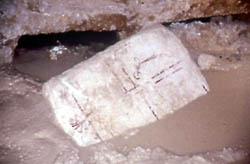 |
|
|
|
|
|
|
|
|
|
|
|
|
|
|
|
|
|
|
|
Photos
: CEA archives all rights reserved |
|
|
|
In
a chamber situated on a lower level (B1.7), to which access was gained by
a stairway of twelve steps, the excavation was made difficult by the water
table. Nevertheless, it proved to be very rich in artefacts : perfume vases,
tableware, lamps, terra cotta statuettes and incense burners. An initial
study dates these to the second half of the 3rd and the 2nd centuries BC.
One of the loculi held five hydrias of Hadra dated to the years 230-220
BC. A certain number of loculi were still sealed by their slabs, some
painted with a door or bearing a funerary inscription, or indeed with
neither décor nor inscription. |
|
|
|
|
|
|
|
|
|
|
|
|
|
|
|
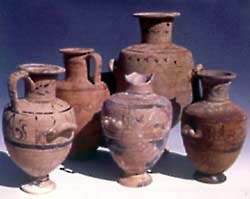 |
|
|
|
|
|
|
|
Aside
from burial, the Greeks also practised cremation and little niches were carved
out of the tomb walls to hold cinerary urns. These vases, known as hydrias of
Hadra when painted, were used as cinerary urns between 250 and 180 BC in the
necropoli of Alexandria. They are mostly of Cretan manufacture, however, an
Alexandrian workshop functioned between 240 and 210 BC, their product being
recognisable from the clay used and from certain characteristics of the décor.
Sometimes these hydrias carried an inscription with the name of the deceased
and were stoppered with plaster, which, in certain cases, bore the seal of the
person in charge of the burial. |
|
|
|
|
|
|
|
|
|
|
|
|
|
|
Hydrias of Hadra, Cretan manufacture, 3rd century
BC |
|
|
|
|
|
|
|
|
|
|
|
|
|
|
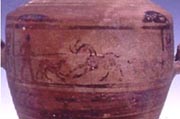 |
|
|
|
|
|
|
|
|
|
|
|
Painted
slabs |
|
|
|
|
|
|
|
|
|
|
|
|
|
|
|
|
|
|
|
|
|
|
|
|
|
|
|
|
|
|
|
The
decoration on a loculus' slab most often represented a door. In the simplest
of examples the door is represented by a frame perhaps topped by a moulded,
decorated lintel. A little more complex is a door topped by a pediment resting
on a lintel. Garlands are painted hanging down from the acroteria of the
pediment. These painted garlands reproduced the real ones that were customarily
offered in honour of the dead. The most complete decoration would show the
door and its frame flanked by pilasters of an architectural order bearing
the entablature and the pediment (see below). |
|
|
|
|
|
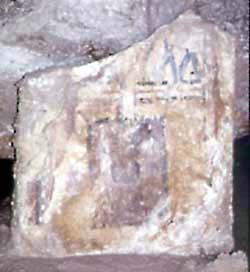 |
|
|
|
|
|
|
|
|
|
|
 |
|
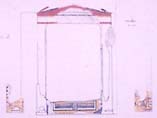 |
|
|
|
|
|
|
|
The
decoration of this slab presents a classic scene of farewell. In front of
the door one sees the deceased sitting and shaking the hand of a standing
man who wishes her well. (Click on the image for details.) |
|
|
|
|
|
|
|
|
|
|
|
|
|
|
|
|
|
|
 |
|
|
|
|
|
|
|
|
|
|
|
|
|
|
 |
 |
 |
 |
 |
 |
 |
 |
 |
 |
 |
 |
 |
 |
 |
 |
 |
 |
 |
 |
 |
 |
 |
 |
 |
 |





